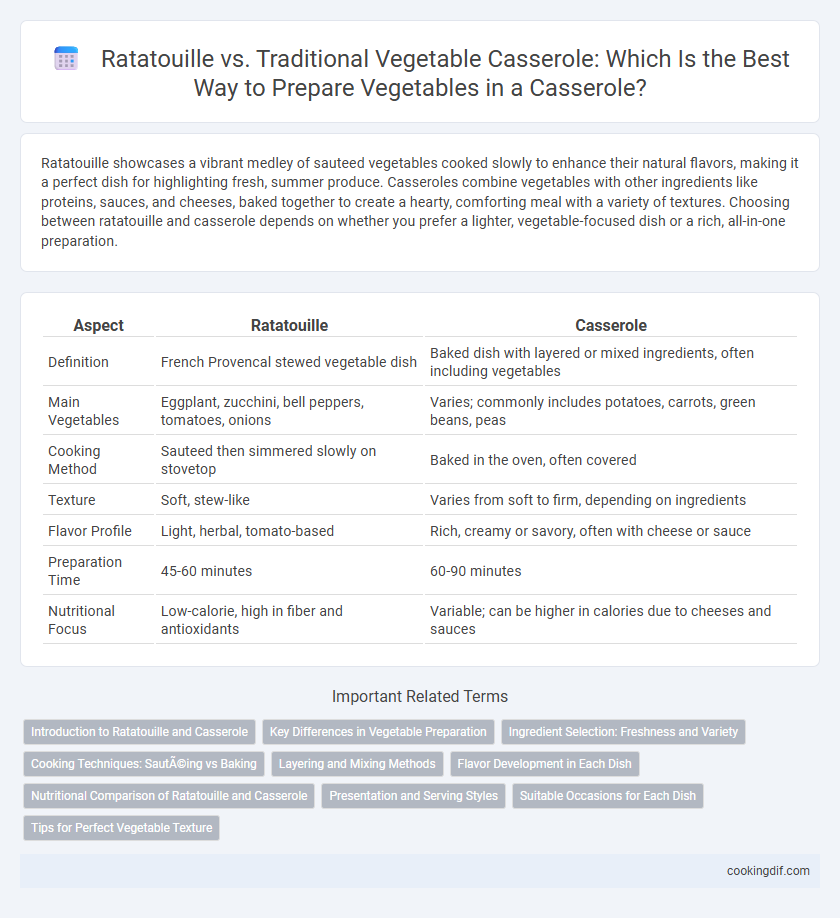Ratatouille showcases a vibrant medley of sauteed vegetables cooked slowly to enhance their natural flavors, making it a perfect dish for highlighting fresh, summer produce. Casseroles combine vegetables with other ingredients like proteins, sauces, and cheeses, baked together to create a hearty, comforting meal with a variety of textures. Choosing between ratatouille and casserole depends on whether you prefer a lighter, vegetable-focused dish or a rich, all-in-one preparation.
Table of Comparison
| Aspect | Ratatouille | Casserole |
|---|---|---|
| Definition | French Provencal stewed vegetable dish | Baked dish with layered or mixed ingredients, often including vegetables |
| Main Vegetables | Eggplant, zucchini, bell peppers, tomatoes, onions | Varies; commonly includes potatoes, carrots, green beans, peas |
| Cooking Method | Sauteed then simmered slowly on stovetop | Baked in the oven, often covered |
| Texture | Soft, stew-like | Varies from soft to firm, depending on ingredients |
| Flavor Profile | Light, herbal, tomato-based | Rich, creamy or savory, often with cheese or sauce |
| Preparation Time | 45-60 minutes | 60-90 minutes |
| Nutritional Focus | Low-calorie, high in fiber and antioxidants | Variable; can be higher in calories due to cheeses and sauces |
Introduction to Ratatouille and Casserole
Ratatouille is a traditional French Provencal stewed vegetable dish known for its vibrant mix of eggplant, zucchini, tomatoes, bell peppers, and aromatic herbs. Casserole is a versatile, oven-baked dish that combines various vegetables, proteins, and sauces into a single hearty meal. Choosing between ratatouille and casserole depends on the desired texture and flavor profile, with ratatouille emphasizing fresh, layered vegetables and casseroles offering a more unified, baked consistency.
Key Differences in Vegetable Preparation
Ratatouille involves precisely layering thinly sliced vegetables like zucchini, eggplant, and bell peppers, allowing each piece to retain distinct textures and flavors through slow baking or simmering. Casserole preparation typically combines chopped or diced vegetables mixed with sauces, cheese, or proteins, resulting in a more homogeneous texture and integrated flavors. The key difference lies in ratatouille's emphasis on visual presentation and individual vegetable integrity versus casserole's focus on a unified, soak-in flavor profile.
Ingredient Selection: Freshness and Variety
Ratatouille emphasizes the use of fresh, vibrant vegetables like zucchini, eggplant, tomatoes, and bell peppers, highlighting seasonal variety to enhance natural flavors. Casseroles offer greater flexibility in ingredient selection, often combining both fresh and preserved vegetables alongside proteins and dairy for richer complexity. Prioritizing freshness in ratatouille ensures a bright, light dish, while casseroles benefit from a balance of fresh produce and complementary ingredients for heartier meals.
Cooking Techniques: Sautéing vs Baking
Ratatouille relies on sauteing vegetables individually to enhance their distinct flavors and maintain texture, creating a layered, aromatic dish. Casseroles typically involve baking mixed vegetables together, allowing flavors to meld while developing a tender, cohesive texture. The choice between sauteing in ratatouille and baking in casseroles significantly impacts the flavor intensity and texture of vegetable preparations.
Layering and Mixing Methods
Ratatouille features a distinct layering method where thinly sliced vegetables are meticulously arranged in concentric circles, enhancing both texture and visual appeal. In contrast, casserole preparation involves mixing chopped vegetables together with sauces and seasonings, creating a homogenous blend that infuses flavors throughout. Layering in ratatouille allows individual vegetable textures to remain pronounced, while mixing in casseroles results in a unified, hearty dish.
Flavor Development in Each Dish
Ratatouille enhances vegetable flavor development through slow simmering, allowing ingredients like eggplant, zucchini, and bell peppers to meld and intensify their natural sweetness and acidity. In contrast, casseroles often combine vegetables with richer components such as cheese, cream, or meat, creating a layered flavor profile that balances savory and creamy notes. The gentle cooking process in casseroles locks in moisture while developing a hearty, comforting taste distinct from the bright, herbaceous essence characteristic of ratatouille.
Nutritional Comparison of Ratatouille and Casserole
Ratatouille typically offers a higher concentration of vitamins A and C due to its fresh tomato, zucchini, and bell pepper ingredients, whereas casseroles may include richer, calorie-dense additions like cheese and cream, increasing fat and protein content. The vegetable-focused nature of ratatouille makes it lower in calories and carbohydrates, making it ideal for nutrient-dense, low-calorie diets. Casseroles provide a more balanced macronutrient profile but often come with higher sodium levels depending on the recipe and added processed ingredients.
Presentation and Serving Styles
Ratatouille offers a visually striking presentation with its meticulously layered, colorful slices of zucchini, eggplant, and tomatoes arranged in a rosette pattern, often served as an elegant side dish or main course. Casseroles present a more rustic, homogenous appearance with mixed vegetables baked in a single dish, ideal for hearty family meals served directly from the oven. Ratatouille emphasizes artistic plating and individual servings, while casseroles prioritize convenience and communal serving styles.
Suitable Occasions for Each Dish
Ratatouille is ideal for elegant dinners, garden parties, or Mediterranean-themed meals, where its vibrant presentation and layered flavors impress guests. Casseroles suit family gatherings, potlucks, and comforting weeknight dinners due to their hearty, all-in-one nature and easy serving style. Both dishes accommodate seasonal vegetables, but ratatouille highlights freshness while casseroles emphasize convenience and warmth.
Tips for Perfect Vegetable Texture
Achieving perfect vegetable texture in ratatouille relies on slow, gentle simmering to soften each vegetable without losing shape, preserving a tender yet distinct bite. In contrast, casseroles benefit from layering vegetables in even sizes and using moderate oven temperatures to ensure uniform cooking and prevent mushiness. For both dishes, salting vegetables beforehand helps draw out excess moisture, concentrating flavors and improving texture consistency.
Ratatouille vs Casserole for vegetable preparation Infographic

 cookingdif.com
cookingdif.com